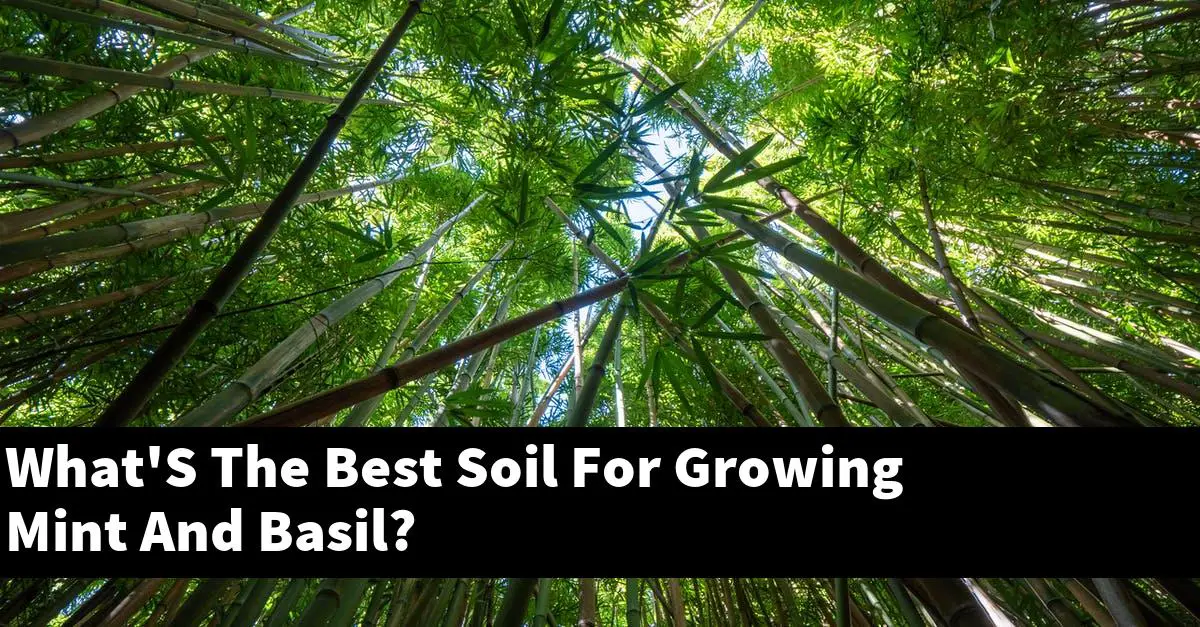Mint and basil are two popular herbs that are often used in cooking. Both herbs require well-drained, moist soil in order to grow properly.
Mint is a hardy plant that can tolerate a wide range of soil conditions, but basil is a bit more delicate and requires a bit more care.
How to grow mint?
Mint is a hardy perennial plant that can be successfully grown in a variety of climates, including cold climates. Mint is often propagated by division of the rootstock, or by taking cuttings of the stem.
Mint should be planted in a well-drained soil with plenty of organic matter. In order to get the most out of mint, it is important to give it plenty of sunlight and water.
What kind of soil do i need for mint?
Mint needs well-drained soil that is acidic, rich in organic matter, and free from weeds. A mix of sand, compost, and loam is ideal.
What soil does basil best grow in?
Basil is a warm-weather plant that prefers well-drained soil with a pH of 6.0 to 6.8. The plant grows best in full sun or part shade.
What is the best soil for basil plants?
There is no definite answer to this question as it depends on the kind of basil plant that you are growing and the soil type that you are using. Some basil plants grow well in heavy soils, while others prefer light soils.
Some people also recommend using organic soil for basil plants.
3 Best soil for mint and basil
There are a few factors to consider when planting mint and basil in soil. Mint prefers a well-drained soil with a pH of 6.0-7.5, while basil prefers a soil with a slightly acidic pH of 5.5-6.5. Both plants prefer a slightly alkaline soil to help with nutrient uptake, but mint is particularly sensitive to high levels of alkalinity.
Finally, both plants are intolerant of heavy metals and pollutants, so it is important to choose a soil that is free of these contaminants.
How do you take care of mint and basil?
Mint and basil are both susceptible to wilting and require careful watering and fertilization. To prevent wilting, keep the plants evenly moist and fertilize them regularly.
To encourage freshness, snip off the bottom of the stem of basil when it begins to go limp.
3 Best soil for spearmint
Spearmint is a herbaceous perennial that is native to Europe and Asia. It can be found in moist areas, such as in the cracks of rocks or in the crevices of tree roots.
Spearmint grows to a height of 1-2 feet and has small leaves that are divided into leaflets. The flowers are small and white and are pollinated by bees.
The leaves and flowers can be used to make a variety of products, such as tea, ointment, and vinegar.
Spearmint grows best in soil that is moist, well-drained, and acidic. It needs full sun and moderate humidity.
It is resistant to frost, but can be damaged by wind and salt.
Can you grow basil and mint together?
Basil and mint can be grown together, but they will not produce as much as they would if they were grown individually. Basil needs a warm, sunny location and mint needs a cool, shaded location.
Basil can be grown in a container, but mint prefers a soil mixture.
3 Best way to grow mint
Mint is a perennial herbaceous plant that typically grows to 1-2 feet tall. It is a soft-stemmed plant with a long taproot.
Mint is hardy in zones 4-9 and prefers full sun to partial sun.
There are several ways to grow mint. One way is to plant mint in a container and water it regularly.
Another way is to plant mint in the ground and water it regularly. The third way is to grow mint in a pot and transplant it to the ground periodically.
Mint is a good plant to grow because it is tolerant of poor soil and can be grown in a variety of climates. It is also easy to propagate by taking cuttings.
What kind of soil do mint plants like?
Mint plants prefer a soil that is well-drained and has a good texture. They are also tolerant of a variety of soil pH levels.
What nutrients does mint need to grow?
Mint needs nitrogen, phosphorus, potassium, and calcium to grow.
3 Best soil for mint in pots
Since mint is a plant that thrives in moist, well-drained soil, a soil mix specifically tailored for mint is a good choice for growing this herb in containers. A good option is a soil mix that is composed of a mixture of peat moss, perlite, and vermiculite.
This mixture is high in organic matter and helps to retain moisture in the soil. Additionally, adding some organic fertilizer to the soil mix will help to support mint growth.
Can i use regular potting soil for mint?
Mint grows best in well-drained, organic soil that is high in organic matter. A good potting mix for mint includes a mixture of equal parts sphagnum moss, peat moss, and perlite.
How to care for mint plant?
Mint plant care is very simple. All you need to do is to water the plant regularly and fertilize it monthly with a balanced organic fertilizer.
You should avoid applying pesticides or herbicides to your mint plant.
In Summary
The best soil for growing mint and basil is a rich, loamy soil that is well-drained. Mint and basil prefer a slightly acidic soil with a pH of 6.0 to 7.0.

